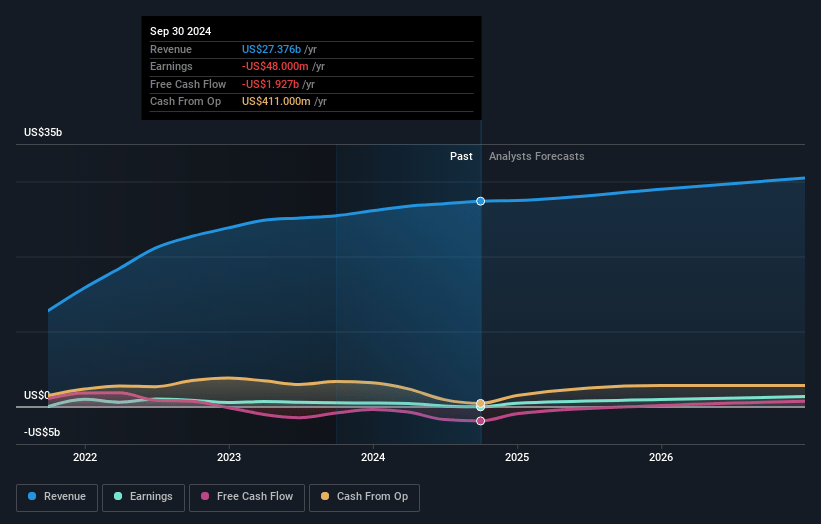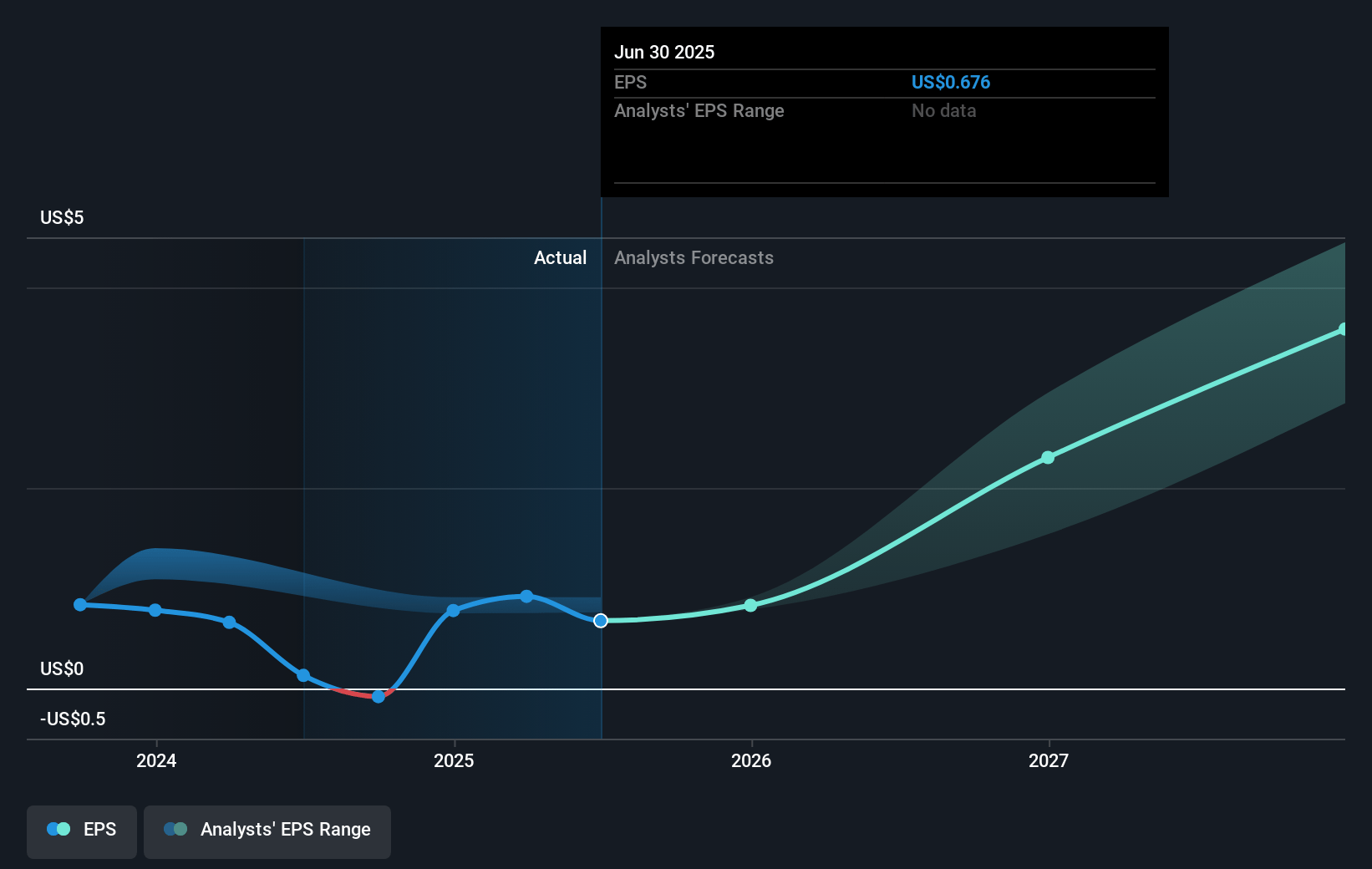Key Takeaways
- Above-normal cost inflation and uncertain savings initiatives threaten Southwest's net margins and earnings growth in the near term.
- Conservative growth assumptions and risks in fleet strategy may result in revenue shortfalls and delayed EBIT improvements.
- Southwest Airlines' strategic initiatives, including efficiency plans and partnerships, aim to enhance customer experience, improve financial structure, and boost revenue and profitability.
Catalysts
About Southwest Airlines- Operates as a passenger airline company that provides scheduled air transportation services in the United States and near-international markets.
- Southwest Airlines is experiencing above-normal unit cost inflation, particularly in market-driven wage rates, airport costs, and health care. This could continue to pressure net margins and earnings if costs are not mitigated promptly.
- The company has a conservative assumption of aircraft deliveries from Boeing, which could lead to slower capacity growth. This challenges revenue growth projections in the future, potentially leading to revenue shortfalls compared to market expectations.
- Although they have plans for a significant cost-saving initiative of $500 million, the pace at which these savings will materialize remains uncertain, potentially impacting the company's ability to enhance net margins and maintain earnings growth as quickly as hoped.
- Southwest's fleet monetization strategy, dependent on receiving adequate Boeing deliveries, could face execution risks. Without sufficient deliveries, selling excess aircraft to unlock value and modernize the fleet could be delayed, compressing anticipated EBIT improvements.
- The intense focus on cost performance and execution speed for strategic initiatives implies significant operational restructuring ahead, which may involve execution risks and transitional costs. These could offset short-term financial gains, impacting earnings and shareholder value in the immediate term.
Southwest Airlines Future Earnings and Revenue Growth
Assumptions
How have these above catalysts been quantified?- This narrative explores a more pessimistic perspective on Southwest Airlines compared to the consensus, based on a Fair Value that aligns with the bearish cohort of analysts.
- The bearish analysts are assuming Southwest Airlines's revenue will grow by 2.9% annually over the next 3 years.
- The bearish analysts assume that profit margins will increase from 1.7% today to 5.2% in 3 years time.
- The bearish analysts expect earnings to reach $1.6 billion (and earnings per share of $2.93) by about April 2028, up from $465.0 million today. The analysts are largely in agreement about this estimate.
- In order for the above numbers to justify the price target of the more bearish analyst cohort, the company would need to trade at a PE ratio of 10.4x on those 2028 earnings, down from 30.5x today. This future PE is greater than the current PE for the US Airlines industry at 8.4x.
- Analysts expect the number of shares outstanding to decline by 0.97% per year for the next 3 years.
- To value all of this in today's terms, we will use a discount rate of 7.39%, as per the Simply Wall St company report.
Southwest Airlines Future Earnings Per Share Growth
Risks
What could happen that would invalidate this narrative?- Southwest Airlines has a transformational plan, Southwest. Even Better, aimed at boosting efficiency, lowering costs, and improving customer experience, which could enhance revenues and profitability.
- The company reported industry-leading operational performance with a high completion factor and improved unit revenue, which may positively impact margins and earnings.
- Ongoing strategic initiatives, including partnerships and a new vacations product, could enhance the Rapid Rewards and co-brand ecosystem, potentially driving higher customer engagement and revenue.
- The execution of a fleet monetization strategy and capital allocation plan, which includes retiring older aircraft and making efficient transactions, could improve the financial structure and margins.
- The company's commitment to cost reductions and efficiency improvements, including a multiyear $500 million cost plan, suggests a potential for better net margins and profitability.
Valuation
How have all the factors above been brought together to estimate a fair value?- The assumed bearish price target for Southwest Airlines is $23.36, which represents one standard deviation below the consensus price target of $29.65. This valuation is based on what can be assumed as the expectations of Southwest Airlines's future earnings growth, profit margins and other risk factors from analysts on the more bearish end of the spectrum.
- However, there is a degree of disagreement amongst analysts, with the most bullish reporting a price target of $42.0, and the most bearish reporting a price target of just $19.0.
- In order for you to agree with the bearish analysts, you'd need to believe that by 2028, revenues will be $29.9 billion, earnings will come to $1.6 billion, and it would be trading on a PE ratio of 10.4x, assuming you use a discount rate of 7.4%.
- Given the current share price of $24.74, the bearish analyst price target of $23.36 is 5.9% lower. The relatively low difference between the current share price and the analyst bearish price target indicates that they believe on average, the company is fairly priced.
- We always encourage you to reach your own conclusions though. So sense check these analyst numbers against your own assumptions and expectations based on your understanding of the business and what you believe is probable.
How well do narratives help inform your perspective?
Disclaimer
AnalystLowTarget is an employee of Simply Wall St, but has written this narrative in their capacity as an individual investor. AnalystLowTarget holds no position in NYSE:LUV. Simply Wall St has no position in the company(s) mentioned. Simply Wall St may provide the securities issuer or related entities with website advertising services for a fee, on an arm's length basis. These relationships have no impact on the way we conduct our business, the content we host, or how our content is served to users. This narrative is general in nature and explores scenarios and estimates created by the author. The narrative does not reflect the opinions of Simply Wall St, and the views expressed are the opinion of the author alone, acting on their own behalf. These scenarios are not indicative of the company's future performance and are exploratory in the ideas they cover. The fair value estimate's are estimations only, and does not constitute a recommendation to buy or sell any stock, and they do not take account of your objectives, or your financial situation. Note that the author's analysis may not factor in the latest price-sensitive company announcements or qualitative material.







